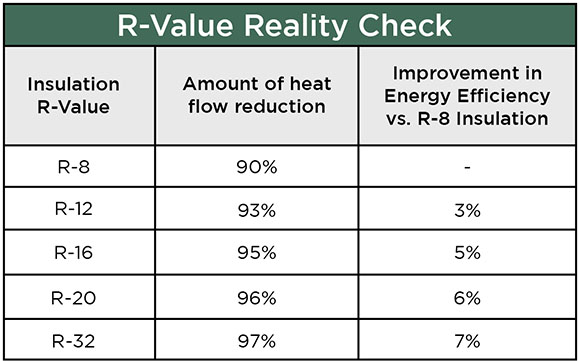Value chart garage door doors insulation amarr energy efficiency guide exterior education residential why does buying complete critical
Table of Contents
Table of Contents
Are you in the market for a new garage door? Did you know that choosing the right R-value for your garage door can make a significant difference in your home’s energy efficiency and comfort? Keep reading to learn more about garage door R-value chart and why it’s crucial to consider.
Pain Points when Choosing a Garage Door R-Value
As a homeowner, you are likely looking to maximize your comfort and minimize your energy bills. You may also want to ensure that your garage is well-insulated to protect your vehicles and belongings from extreme temperatures, humidity, and noise. However, without any knowledge of garage door R-value chart, you might struggle to determine the ideal R-value for your home.
What is Garage Door R-Value and Why is it Important?
Garage door R-value chart determines the insulating power of a garage door. The R-value measures the thermal resistance of the garage door to heat flow, meaning the higher the R-value, the better the insulating capacity of the door. Therefore, if you live in a region with extreme temperatures, it’s essential to look for garage doors with a high R-value to keep your garage comfortable year-round.
Summary of the Article’s main points Related to Garage Door R-Value Chart
In summary, garage door R-value chart is a measurement of the insulating power of a garage door. By choosing the right R-value for your door, you’ll be able to ensure that your garage is energy-efficient and comfortable, regardless of the weather outside. So, it’s essential to consider the R-value when purchasing a new garage door.
What Is the Target of Garage Door R-Value Chart?
The target of garage door R-value chart is to help homeowners choose a garage door that provides optimal insulation and energy efficiency. By providing a standardized measurement of the insulating power of garage doors, you can compare different models and select the most suitable one for your home.
When I was shopping for my new garage door, I was unaware of the garage door R-value chart. However, with some research, I learned that a higher R-value means better insulation, and as such, lower energy bills. After choosing the right R-value for my door, I have noticed a significant reduction in my energy bills, and my garage is much more comfortable than before.
How to Choose the Right R-Value for Your Garage Door
Choosing the right R-value for your garage door depends on various factors, including the climate in your region, the use of your garage, and the construction of your home. Generally, an R-value of 10-13 would be adequate for most homes. However, if you live in extremely cold or hot climates, consider a higher R-value for better insulation.
Tips for Improving Garage Door Insulation
There are various ways to improve garage door insulation, including integrating different insulation materials on the door, installing weather-stripping, and insulating the garage walls and ceiling. Using a combination of these methods can significantly boost the R-value of your garage door and improve your home’s energy efficiency and comfort.
Investing in a High R-Value Can Save You Money and Boost Your Home’s Energy Efficiency
A high R-value garage door may cost more upfront, but it can save you money in the long run by reducing your energy bills. Additionally, it can prevent air leakage, reduce noise, and protect your belongings from extreme weather conditions.
Question And Answer
Q: Can I Insulate My Current Garage Door?
A: Absolutely. You can add insulation panels to your existing garage door or install weather-stripping around the edges to improve insulation.
Q: Which is Better, Polyurethane or Polystyrene Insulation?
A: Both insulation types provide good thermal resistance, but polyurethane tends to offer higher R-values, making it more energy-efficient.
Q: How Do I Know What R-Value to Choose For My Garage Door?
A: Consider the climate in your region, the use of your garage, and the construction of your home when choosing the right R-value for your garage door. Additionally, consult a garage door professional for guidance on the best insulation options for your home.
Q: How Often Should I Replace My Garage Door?
A: A well-maintained garage door can last up to 30 years. However, if your garage door is damaged or has worn-out components, it’s essential to replace it to ensure optimal performance and safety.
Conclusion of Garage Door R Value Chart
In conclusion, garage door R-value chart is a crucial consideration when purchasing a garage door. By choosing the right R-value, you can improve your home’s energy efficiency, boost your comfort, and reduce your energy bills. Additionally, by understanding how to improve your garage door insulation, you can save money while protecting your belongings and vehicles from extreme weather conditions. Contact a garage door professional today to learn more about the best insulation options for your garage door.
Gallery
What R-Value Should My New Garage Door Have?

Photo Credit by: bing.com / garage value door should insulation factor choices selecting operating involve systems colour windows another many right style
Garage Door Education: R-Value 101 | Amarr Garage Doors

Photo Credit by: bing.com / value chart garage door doors insulation amarr energy efficiency guide exterior education residential why does buying complete critical
Garage Door R Value | Garage Doors Repair

Photo Credit by: bing.com / garagedoorsrepair
What Is Garage Door R-Value | Quality Overhead Door

Photo Credit by: bing.com / qualityoverheaddoor
What Is Garage Door R-Value? | Garage Door Insulation

Photo Credit by: bing.com / insulation heat





